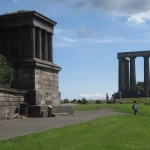Historic Building Conservation, Scotland Heritage Movement, Scottish Capital City Architecture
Edinburgh Conservation : Architecture
Design discussion from Charles McKean, Gordon Murray, Alan Dunlop, Richard Weston
1 Jul 2001
Editorial for July 2001
By Scottish architect Adrian Welch
Edinburgh Building Conservation
Last month saw a lot of discussion (partly due to Architecture Week) about the kind of city we wish to live in. Charles McKean’s talk at the RIAS and online article with The Scotsman, Gordon Murray and Alan Dunlop’s response, Richard Weston’s diatribe against the dark forces of conservatism, a presentation by ECCMG on renewing Princes Street, campaigns against various new proposals, and, of course, the never-ending ‘tedious’ chatter about the new Scottish Parliament. Refer to Princes Street Shopping and Princes Street Gardens.
A lot of the heat was generated by the usual posturing of different camps, all with their own agenda, but I feel there is a new issue: professional campaign groups challenging new architecture. I will write about this in more detail in next month’s Prospect magazine, but the essence is that architects and their Clients are fighting a whole new ball game. The days of a few letters to the Planning Office seem to be over. Campaigners are getting better at mobilising, and the Jeffrey Street campaign even has a web-site. This is not all bad, as the pressure can make architects and their clients raise their game. The balance has to be generated that doesn’t stifle good new buildings, but forces developers to listen to local communities, and to increase quality of design and materials.
Current controversies – Edinburgh Science Centre, Jeffrey Street, Circus Lane – mostly revolve around loss of space and consequently views. The business community (the two former schemes) are at loggerheads with local residents, often aided by conservation groups. Bizarrely in the case of Circus Lane, the Edinburgh World Heritage Trust (EWHT) supported the scheme, though strangely they complained about Oloroso, a rooftop restaurant – also by Richard Murphy Architects – with no new facade. In July’s edition of ‘Insider’ the leader of the Council – Donald Anderson – worries that Scottish Executive civil servants are paying too much attention to Edinburgh applications because they know the city better: “…they are paying much more attention to developments than we are comfortable with – much more than they have done in the past…I would hope that we are not going to be sending signals that Edinburgh is not for development”.
One thing is obvious (having just returned from Copenhagen where radical new buildings dot the city centre) is that contemporary architecture in the World Heritage site has to be good-mannered to the point of being a little stiff. The design of the three schemes mentioned above (see the Science Centre and Jeffrey Street models at 1 Cockburn Street reception) is in each case excellent, picking up on the heights and line of neighbouring buildings and using well-crafted forms. The Science Centre cuts back in a series of deft inflections, and Jeffrey Street forms a flowing prow, a welcome piece of organic design in our mostly-orthogonal centre.
None of these schemes, however, has really stuck its head above the parapet like say Zhandra Rhodes’ textile museum in south London, or the ‘Telephone’ building in Copenhagen’s town square. We don’t have to emulate other cities, but it has to be noted that we are severely restricting creativity in the centre. Is this what we want for a dynamic living city, a city aspiring to be one of Europe’s best capitals? Jeremy Dixon.Ed Jones’ recent comments about their National Portrait Gallery extension in London having no real external facade due to pressure from planning ring true in Edinburgh too. With Circus Lane rejected, and the ‘other two’ in planning, the next month will hopefully provide some answers on which way we are going.
Addendum, 11.07.01
So the RFAC have ‘condemned’ proposals by the Crowne Plaza Hotel on the High St for luxury beds on a gap site and also replacing an existing stone hostel and B-listed Morton House. This evokes the great controversy when the Scandia (now the Crowne Plaza) Hotel proposed a mock vernacular multi-storey block: then, as now, the style was deemed by many to be unsuitable pastiche. The hostel to be replaced is a useful central resource and should be retained: the character of the area would surely not be helped by a monopoly of usage in one huge block.
Addendum, 20.07.01
This week’s granting of permission for the expansion of Edinburgh Park to the south will ease pressures on the city centre and in a way, possibly put off a more involved debate about how to insert functioning modern offices into our historic core. We hope that NEL will be talking to some creative and inspiring architects for this new phase, and we wish them well.
Scottish Capital Architecture
Contemporary Scottish Capital Architecture Designs – recent architectural selection below:
Edinburgh Building Designs
Edinburgh Property Designs – selection below:
West Town Edinburgh 20-minute neighbourhood
image courtesy of architects practice
1 Broughton Market short term let apartments
Comments / photos for the Edinburgh Historic Building Conservation Architecture page welcome



